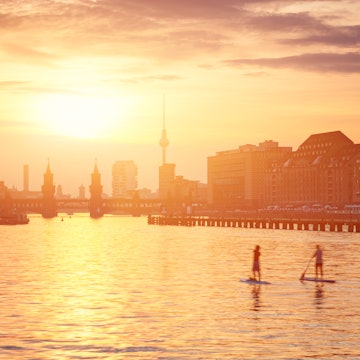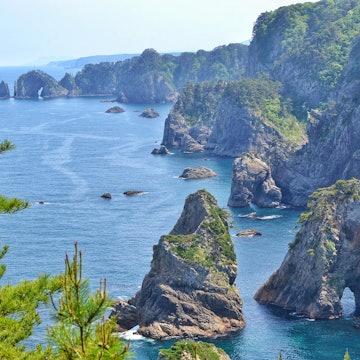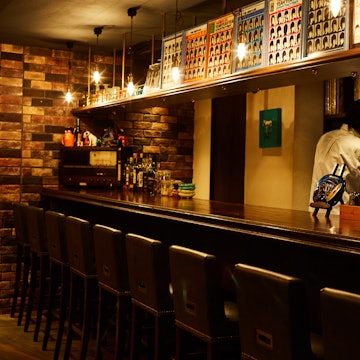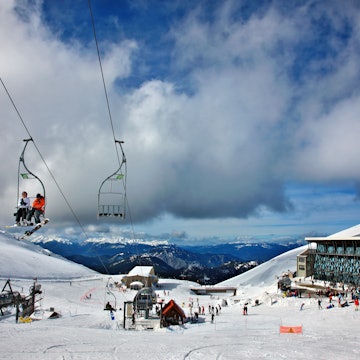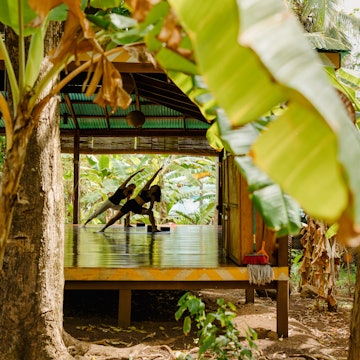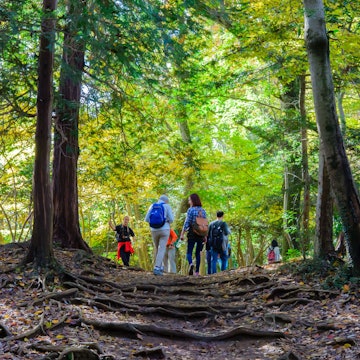

Walkers on the Kumano Kodō in the Kii Peninsula. LLUCO / Shutterstock
One of Japan's most remote and rewarding journeys, the Kumano Kodō hiking route weaves through the mountainous Kii Peninsula, south of Osaka. Once a sacred pilgrimage trail reserved for emperors and samurai, the ‘Kumano Old Road’ is today open to all seekers and wanderers, with plenty of intensely photogenic shrines and natural beauty along the way.

From old road to World Heritage Site
Even before organised religion existed in Japan, locals worshipped nature in the Kii Peninsula's mystical landscape. Towering trees, the nation's tallest waterfall, and the mountains in between were themselves considered kami (gods), and a walk among them a sacred act. Emperors and samurai from Kyoto kept detailed diaries of their pilgrimages here; one of the earliest was by an aristocrat who travelled to Kumano in 1109.
Over the years Buddhist temples and shrines of Shintō, Japan's native religion, were built; and in 2004, the Kumano Kodō and its sacred sites were given World Heritage status – one of only two pilgrimage routes recognised by Unesco (the other is the Santiago de Compostela in Spain and France).

Pick your pilgrimage
The Kumano Kodō is not one route but a network of trails through the deeply forested mountains, with no official start or end point and no prescribed hiking order. Moderate to strenuous hiking options last a few hours to several days, taking in some of Japan’s top ‘power spots’ – temples, forests and waterfalls thought to enrich the soul. While purists may want to hike the entire way, there’s no shame in riding the buses that circulate between the sights and trailheads.
Historically, pilgrims would visit the three grand Shintō shrines of Kumano – collectively known as Kumano Sanzan – cornerstones of the Nakahechi route (aka the Imperial Route), the most action-packed way through the region.
Hiking the Nakahechi route
On the Kii Peninsula's west coast, Tanabe (aka Kii-Tanabe) is the gateway to Kumano, offering one last micro-glimpse of the modern world before setting out. Fortify yourself the night before your journey with sashimi, yakitori, sake and the local speciality umeshu (Japanese apricot liqueur, sometimes mistakenly called 'plum wine') in one of many atmospheric izakaya (Japanese pubs).
From Tanabe, a 40-minute bus ride takes you to the start of the route at the Shintō shrine Takijiri-ōji, where centuries of pilgrims used to perform ablutions in the healing river waters before commencing their journey.
A 4km hike opens with a steep uphill climb and rambles along tree roots and boulders before arriving in Takahara, nicknamed 'the village in the mist', a good place to bed down for the night.

Many visitors opt to forgo the next 13km hike – with an elevation gain of 830m – for a bus ride to the next town of Tsugizakura and its groves of ancient pines; it's a 25-minute hike from Takahara to the bus stop, and another 25 minutes' walk from the bus stop to Tsugizakura.
Fit hikers can cover the next 21.5km in about 8 hours, via isolated villages, forest trails and an inspirational lookout point to Kumano Hongū Taisha, first of the grand shrines, perched over a tree-covered ridge. Near the shrine, the modern Kumano Hongū Heritage Centre provides museum-quality descriptions in English about the route and World Heritage Sites. Japan's largest torii (Shintō shrine gate), nearly 40m tall, stands nearby.

Midway through the next 27.5km (about 1.5 days) is the toughest part of the hike, the forebodingly named Dogiri-zaka (body-breaking slope) – about 5km straight uphill for an 800m gain in elevation. It’s been notorious for centuries; one 13th-century poet hiker wrote ‘it is impossible to describe precisely how tough it is.’
Your reward is a stop at Nachi-no-taki, Japan's tallest waterfall (133m), subject of countless photos and the backdrop to the brilliant orange pagoda across the valley. The waterfall is the kami (god) enshrined at the adjacent Kumano Nachi Taisha, the second of the grand shrines of the area.

To reach the last shrine, Kumano Hayatama Taisha, you might travel from the Hongū area as the ancients did, down the river Kumano-gawa by traditional flat-bottomed boat, to where it empties into the vast Pacific at the town of Shingū (or kayaks and motorised boats are also available). At the shrine, an 800-year-old pine tree – itself considered sacred – makes a fitting end to the trail.
Day-tripping Kumano
Not up for hiking? You can day trip from Osaka to some of Kumano's best-known sights. Limited express Kuroshio trains circle around the peninsula to Kii-Katsuura station in about 3.5 hours; from here it's a 25-minute bus ride to the shrine area. For a taste of the hiking experience, break a serious sweat by ascending to the main shrine building via a fantastical, 800m tree-lined arcade. With a little extra time, return to Kii-Katsuura station and continue by train to Shingū and Kumano Hayatama Taisha.
From Osaka’s Kansai Airport, catch a train to Hineno, where you can transfer to Kuroshio trains.
Detours, hot-spring villages and Kōya-san
An easy bus ride or about 3.5km walk from Hongū is a trio of connected onsen (hot spring) villages, where inns and waters have soothed bodies and souls for centuries. Note that the custom at Japanese hot-spring resorts is to go au naturel (most are gender-separate); use changing areas and small modesty towels, and inquire before setting out if you have tattoos as many baths in Japan prohibit guests sporting ink.
A good choice is picturesque Yunomine Onsen, where a stream rushes downhill through the centre of the hamlet, and small ryokan (traditional inns) boast some rustically beautiful baths. Watarase Onsen is home to a large indoor-outdoor bathing complex surrounded by larger inns. The most unusual is Kawa-yu Onsen, where hot water bubbles through small stones into the riverbed; and bathers carve out makeshift tubs from the river stones before dipping in. Note: a swimsuit is required at Kawa-yu.
Related content:
How to soak up wellness in Wakayama's onsens
With more time to explore the region, two longer routes are the Ohechi and Iseji trails. The Ohechi’s unimpeded views of the Pacific, around the peninsula’s southern coast, made it a favourite of worshippers, sightseers, writers and artists during the Edo Period (1603-1868). Iseji, meanwhile, connects to the northeast with the Ise Grand Shrine, considered Shinto’s most sacred, in neighbouring Mie Prefecture.
Another side trip north of Kumano Kodō, the mountaintop Kōya-san is a palpably spiritual temple complex, headquarters of the Shingon sect of Esoteric Buddhism and also on the Unesco World Heritage list. Only the fittest, most dedicated hikers will want to hike the 70km Kohechi trail from Kumano; for the rest of us there are a couple of daily bus connections. That said, most visitors visit Kōya-san as a standalone trip from Osaka (there are several daily trains), while a new direct bus line from Kyoto saves time and train transfers.
Related content:
Exploring Kōya-san: staying at Japan’s sacred mountaintop temple complex

When to go
Although the Nakahechi route is open year-round, during peak seasons (spring and autumn), the weather is the most reliably temperate and reservations are advised well in advance. The Obon holiday season in mid-August can also get quite busy.
Where to stay
There are plenty of places to stay throughout the region, but the greatest concentration is in the towns of Tanabe and Katsuura. In between, the route is lined with small guesthouses, ryokan and minshuku (family-run inns). Most of these inns feel like a step back in time, and especially in the small villages you can expect an authentic Japanese experience; even in recently constructed lodgings, most accommodations are traditional style with futon bedding on tatami mat floors, shared baths and local cuisine.
Lodgings in the hot-spring villages near Hongū are well worth the detour, with standards from basic to deluxe (though not luxury).
Visit the Kumano Tourism Board’s accommodations site to view options and make reservations.
Make it happen
The Tanabe City Kumano Tourism Board is an excellent resource for planning a visit. It operates the comprehensive Travel Support Centre in Tanabe, across from the train station, and offers detailed guide maps to the region and multilingual accommodation booking service, all available online.
This article was published September 2017 and updated October 2019.







